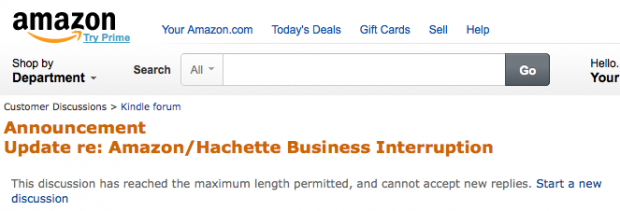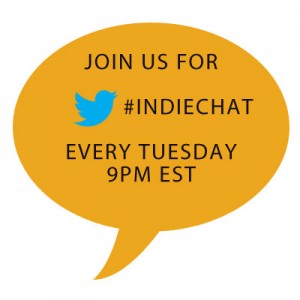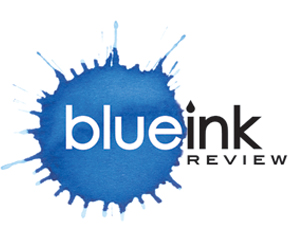Amazon hasn’t commented or said much about their ongoing contract battle with Hachette. Earlier today, on their forums they broke their silence and released an official statement.
I wrote my thoughts about the battle over on PBS MediaShift. I’ve cut and paste the statement below. Looks like the biggest point of contention (or what seems to be the biggest point of contention) is that Hachette is trying to raise ebook prices and Amazon is trying to keep the majority of ebooks below $9.99.

With this update, we’re providing specific information about Amazon’s objectives.
A key objective is lower e-book prices. Many e-books are being released at $14.99 and even $19.99. That is unjustifiably high for an e-book. With an e-book, there’s no printing, no over-printing, no need to forecast, no returns, no lost sales due to out-of-stock, no warehousing costs, no transportation costs, and there is no secondary market — e-books cannot be resold as used books. E-books can be and should be less expensive.
It’s also important to understand that e-books are highly price-elastic. This means that when the price goes up, customers buy much less. We’ve quantified the price elasticity of e-books from repeated measurements across many titles. For every copy an e-book would sell at $14.99, it would sell 1.74 copies if priced at $9.99. So, for example, if customers would buy 100,000 copies of a particular e-book at $14.99, then customers would buy 174,000 copies of that same e-book at $9.99. Total revenue at $14.99 would be $1,499,000. Total revenue at $9.99 is $1,738,000.
The important thing to note here is that at the lower price, total revenue increases 16%. This is good for all the parties involved:
* The customer is paying 33% less.
* The author is getting a royalty check 16% larger and being read by an audience that’s 74% larger. And that 74% increase in copies sold makes it much more likely that the title will make it onto the national bestseller lists. (Any author who’s trying to get on one of the national bestseller lists should insist to their publisher that their e-book be priced at $9.99 or lower.)
* Likewise, the higher total revenue generated at $9.99 is also good for the publisher and the retailer. At $9.99, even though the customer is paying less, the total pie is bigger and there is more to share amongst the parties.
Keep in mind that books don’t just compete against books. Books compete against mobile games, television, movies, Facebook, blogs, free news sites and more. If we want a healthy reading culture, we have to work hard to be sure books actually are competitive against these other media types, and a big part of that is working hard to make books less expensive.
So, at $9.99, the total pie is bigger – how does Amazon propose to share that revenue pie? We believe 35% should go to the author, 35% to the publisher and 30% to Amazon. Is 30% reasonable? Yes. In fact, the 30% share of total revenue is what Hachette forced us to take in 2010 when they illegally colluded with their competitors to raise e-book prices. We had no problem with the 30% — we did have a big problem with the price increases.
Is it Amazon’s position that all e-books should be $9.99 or less? No, we accept that there will be legitimate reasons for a small number of specialized titles to be above $9.99.
One more note on our proposal for how the total revenue should be shared. While we believe 35% should go to the author and 35% to Hachette, the way this would actually work is that we would send 70% of the total revenue to Hachette, and they would decide how much to share with the author. We believe Hachette is sharing too small a portion with the author today, but ultimately that is not our call.
We hope this information on our objectives is helpful.
Thank you,
The Amazon Books Team







Follow Us!